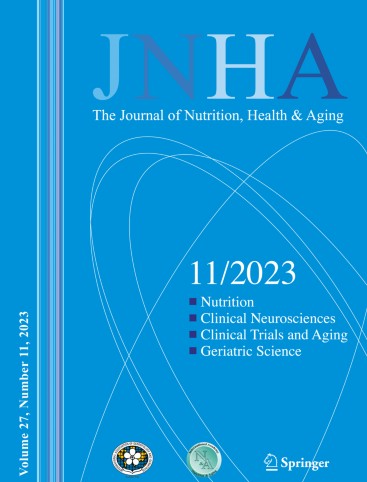路易体痴呆患者与阿尔茨海默病患者的内在能力比较:一项横断面研究
IF 4
3区 医学
Q1 GERIATRICS & GERONTOLOGY
引用次数: 0
摘要
目的:本征能力(IC)是个体所有生理和心理能力的总和,从未在路易体痴呆患者中进行过研究。由于IC下降与虚弱、功能下降和残疾的风险相关,并且在有针对性的干预后可能是可逆的,因此对DLB患者IC下降的监测和具体管理可以促进该人群的健康老龄化。本横断面研究的目的是描述DLB中IC下降的频率,并将其与AD进行比较。设计单中心横断面研究。本研究于2015年至2023年在一家记忆诊所进行,基于MEMORA队列。参与者:诊断为AD或可能为DLB的患者,并进行全面的老年评估。根据WHO模型对sic进行4个方面的评估:活力评估采用迷你营养评估(MNA),运动评估采用短物理性能电池(SPPB),心理评估采用老年抑郁量表4项(GDS-4),听力评估采用听力、视觉、平衡和认知(HVEC)量表。结果共纳入798例患者,其中疑似DLB 154例,AD 644例,平均年龄81.4岁(SD 6.33)。根据调整后的模型,与AD患者相比,DLB患者在所有领域的IC受损明显更多,活力(比值比(OR) 2.43, 95%置信区间(CI) 1.60-3.72)、运动(OR 3.50, 95% CI 2.15-5.90)、心理(OR 2.60, 95% CI 1.73-3.92)和听力(OR 2.30, 95% CI 1.53-3.49)受损的风险更大。同样,当IC域被认为是线性变量时,DLB组所有域的IC明显低于AD组。结论本研究显示,在所有领域中,DLB患者的IC下降幅度大于AD患者。记忆门诊可对DLB患者进行系统、早期的IC监测和个性化干预。本文章由计算机程序翻译,如有差异,请以英文原文为准。
Intrinsic capacity in patients with dementia with Lewy bodies compared with those with Alzheimer’s disease: A cross-sectional study
Objectives
Intrinsic capacity (IC), the composite of all the physical and mental capacities of an individual, has never been studied in patients with dementia with Lewy bodies (DLB). As IC decline is associated with the risk of frailty, functional decline and disability and is potentially reversible after targeted interventions, a monitoring and specific management of IC decline in patients with DLB could promote healthy aging in this population. The aim of this cross-sectional study was to describe the frequency of IC decline in DLB and to compare it with AD.
Design
A single-center cross-sectional study.
Setting
This study was carried out in a memory clinic between 2015 and 2023 based on the MEMORA cohort.
Participants
Patients with a diagnosis of AD or probable DLB and a comprehensive geriatric assessment.
Measurements
IC was assessed according to the WHO model in 4 domains: vitality assessed by the Mini Nutritional Assessment (MNA), locomotion assessed by the Short Physical Performance Battery (SPPB), psychology assessed by the Geriatric Depression Scale 4-items (GDS-4 items), and hearing assessed by the Hearing, Vision, Equilibrium and Cognition (HVEC) scale.
Results
A total of 798 patients (154 with probable DLB and 644 with AD) were included, and the mean age was 81.4 years (SD 6.33). Compared with AD patients, DLB patients had significantly more impaired IC in all domains, with greater risks of impaired vitality (odds ratio (OR) 2.43, 95% confidence interval (CI) 1.60–3.72), locomotion (OR 3.50, 95% CI 2.15–5.90), psychology (OR 2.60, 95% CI 1.73–3.92) and hearing (OR 2.30, 95% CI 1.53–3.49), according to the adjusted models. Similarly, when IC domains were considered linear variables, IC across all domains was significantly lower in the DLB group than in the AD group.
Conclusion
This study revealed that DLB patients presented a greater decrease in IC than did AD patients across all domains. In memory clinics, DLB patients could be offered systematic and early IC monitoring and personalized interventions.
求助全文
通过发布文献求助,成功后即可免费获取论文全文。
去求助
来源期刊
CiteScore
7.80
自引率
3.40%
发文量
136
审稿时长
4-8 weeks
期刊介绍:
There is increasing scientific and clinical interest in the interactions of nutrition and health as part of the aging process. This interest is due to the important role that nutrition plays throughout the life span. This role affects the growth and development of the body during childhood, affects the risk of acute and chronic diseases, the maintenance of physiological processes and the biological process of aging. A major aim of "The Journal of Nutrition, Health & Aging" is to contribute to the improvement of knowledge regarding the relationships between nutrition and the aging process from birth to old age.

 求助内容:
求助内容: 应助结果提醒方式:
应助结果提醒方式:


